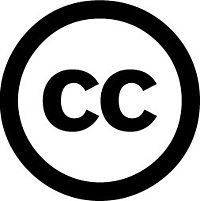Kelly draft two
From DigitalRhetoricCollaborative
[edit] Creative Commons

Creative Commons is a nonprofit organization that works to make creative projects available to be legally shared, used, and built upon. Creative Commons
releases copyright-licenses for people to use to protect their work, while giving the opportunity for their work to be part of a creative process by others. [1] Creative Commons offers a range of licenses, each grant different rights to the work under the license; “All of the licenses offer more permission than ‘all rights reserved.’” It is part of the copy leftists’ movement, a movement that feels copyright is too rigid and is not conducive to creative practice.[2] The licenses, which are free of charge to the public, specify which rights are reserved and which ones are not. Creative commons supports the idea of the web as a public domain.
Contents |
[edit] History
Creative Commons was founded in 2001 with support of the Center for the Public Domain. It was founded by Lawrence Lessig, Hal Abelson, and Eric Eldred. A board of directors leads Creative Commons; the board of directors is comprised of investors, philanthropists, entrepreneurs, and professionals in many fields like education, technology, and law. [3]
In December 2002, they released its first set of Copyright Licenses that were free to the public. The licenses were in part inspired by the Free Software Foundation’s GNU General Public License (GNU GPL). In the years following the release, Creative Commons grew exponentially and were ported to over 50 affiliate networks.
In 2003, there were approximately one million dollars in use. By 2004, there were an estimated 4.7 million licensed by the end of the year. In that year, License 2.0 was released. In the following year 2005, Creative commons grew to over 20 million licensed works. Some improvements were made and License 2.5 was released before year-end. [4]
In 2005, Creative Commons created the Science Project. The project build commons based infrastructure for science; they identified and lowered “the through identifying and lowering unnecessary barriers to research, crafting policy guidelines and legal agreements, and developing technology to make research, data and materials easier to find and use.”
In 2007, the licenses in use reached approximately 90 million. On the fifth birthday of the licenses, License 3.0 was released. The education project was released. Like the science project, it created an infrastructure to make education tools and projects easier to use and share. In the following year, the licenses almost doubled, and Lawrence Lessig stepped down from his position of CEO.
In 2009, licenses in use reached 350 million. Wikipedia migrated to Creative Commons: Attribution – ShareAlike as its content licensing. They released CC0.[5]
As of Novemeber, 2014, 882 Million licenses in use. As of 2015, there are more than 100 affiliates working in 75 jurisdictions around the world. [6]
[edit] Creative Commons vs. Copyright
While Creative Commons is considered to lead the copy leftist movement, they do not see themselves as being against Copyright entirely. Creative Commons promotes Copyright reform. Their website states that “while free licensing is important, it is not enough to reform copyright alone.” Creative Commons serves as an alternative or an accompaniment to copyright. [7]
"The point of Creative Commons is to provide a middle ground between two extreme views of copyright protection—one demanding that all rights be controlled, and the other arguing that none should be controlled. Creative Commons provides a third option that allows authors to pick and choose which rights they want to control and which they want to grant to others. The multitude of licenses reflects the multitude of rights that can be passed on to subsequent creator.” - Lawrence Lessig [8]
[edit] CC0
In 2009, Creative Commons released a new infrastructure for licensing called CCO. It allows artists, designers, educators, scientists, creators and “owners of copyright- or database-protected content to waive those interests in their works” and thereby place them in the public domain, so others may “freely build upon, enhance and reuse the works for any purposes without restriction under copyright or database law.” CC0 is licensing infrastructure that works to serve the public domain. It is for creators that want to share their work in as whole a form as possible to be part of the creative process. Creative Commons users chose from a range or permissions available while retaining copyright. “While CC0 empowers yet another choice altogether, – the choice to opt out of copyright and database protection, and the exclusive rights automatically granted to creators” – the “no rights reserved” alternative to Creative Commons licenses. This caters to the copy leftists. [9]
[edit] Some Rights Reserved
Creative Commons offers “some rights reserved” licenses.
The phrase "All Rights Reserved" is used by Copyright owners to indicate they reserve all of the rights granted to them under Copyright law. After, copyright expires, the work goes into the public domain. The rights holder no longer is able to stop others from changing, using, and claiming their work. Creative Commons offer creators and designers a choice between retaining all rights and relinquishing all rights (public domain), “an approach we call ‘Some Rights Reserved.’”
[edit] Using Creative Commons
Many companies have migrated to Creative Commons licenses like: Flickr, Google, Al Jazeera, Nine Inch Nails, Wikipedia, MIT OpenCourse Wave, Whitehouse.gov, Public Library of science. While large companies maintain licenses, most of their licenses are used for personal projects. [10]
Creative Commons is popular with blogs, posted pictures, creative projects. The vision of the company listed on the website is: “Our vision is nothing less than realizing the full potential of the Internet — universal access to research and education, full participation in culture — to drive a new era of development, growth, and productivity.”[11]
[edit] External Links
[edit] References
- ↑ https://wiki.creativecommons.org/FAQ
- ↑ http://libflow.com/d/rj87xv4r/The_Copyleft_Movement%3A_Creative_Commons_Licensing
- ↑ http://creativecommons.org/about/history
- ↑ http://creativecommons.org/licenses/
- ↑ http://creativecommons.org/licenses/by-sa/3.0/
- ↑ http://creativecommons.org/about/history
- ↑ http://creativecommons.org/about/reform
- ↑ http://creativecommons.org/weblog/entry/5719
- ↑ http://creativecommons.org/about/cc0
- ↑ http://creativecommons.org/who-uses-cc/
- ↑ http://creativecommons.org/about
